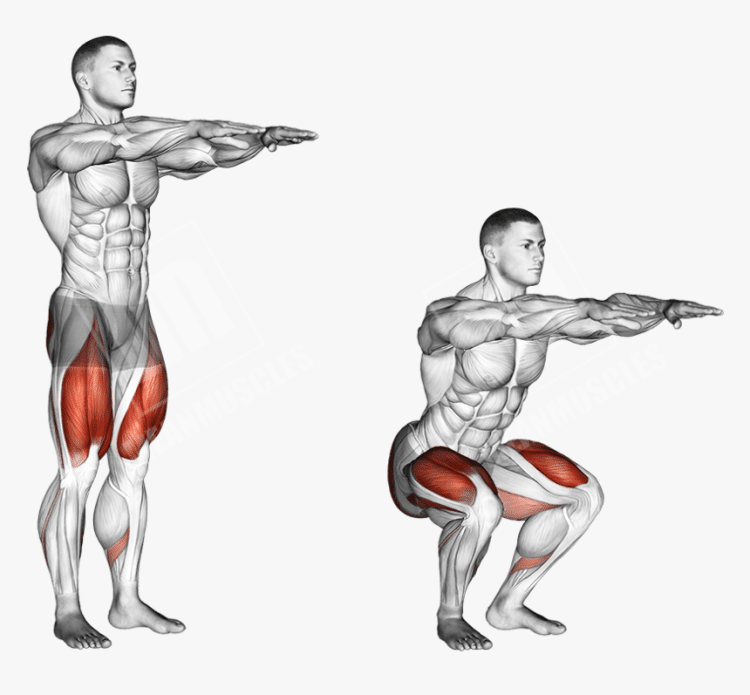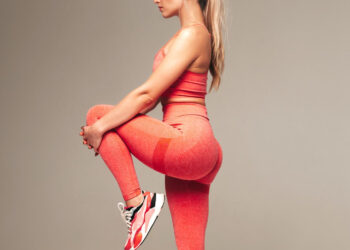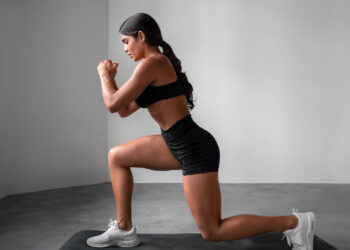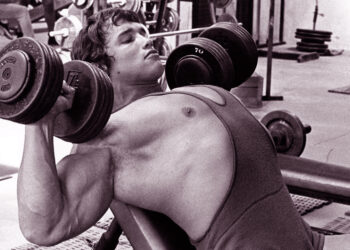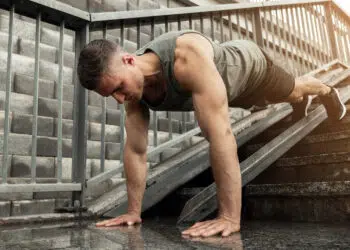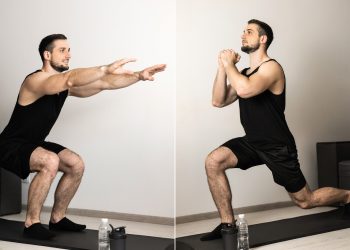Squats are one of the most important exercises you can do. It doesn’t matter if you are training to build bigger muscles, increase your leg strength, burn fat, or tone up; squats will help. They’re also a critical exercise for athletes who want to run faster or jump higher.
Squats aren’t just an exercise either. They’re a movement pattern that most people do many times a day. Sitting down and standing up, getting in and out of your car, and climbing stairs are all examples of squats in daily life. In some cultures, the squat is a resting and working position used in place of chairs.
Kids naturally squat to get themselves closer to the ground, which is a handy skill for playing with Legos! But, as adults, we tend not to squat as often or as deeply. Chairs mean we don’t have to descend as far as we did when we were kids.
Unfortunately, the less you squat, the sooner you’ll lose this important skill. That’s why older people often have such a hard time getting out of a chair, especially if it’s low.
The gold standard for squats is descending to parallel. Sure, a lot of gym memes state that you should go “ass to grass,” but that’s not necessary or possible for many people. Lack of hip and ankle mobility may mean that forcing yourself to squat deeper causes pain and injuries.
Level Up Your Fitness: Join our 💪 strong community in Fitness Volt Newsletter. Get daily inspiration, expert-backed workouts, nutrition tips, the latest in strength sports, and the support you need to reach your goals. Subscribe for free!
Related: How Deep Should You Squat?
So, in this article, we’re going to focus on parallel squats. That’s a good range of motion that most people should be able to achieve.
Can you squat deeper? Of course, you can! But only if you can do so without compromising your joint health, i.e., rounding your lower back or lifting your heels off the floor.
Parallel Squats – Muscles Worked
Parallel squats are a compound lower body exercise. This means they involve multiple muscles and joints working together. Done with weights, the parallel squat also involves several upper body muscles, which are used to support the load you are holding.
The main muscles trained during parallel squats are:
Quadriceps
There are four quadriceps muscles: the rectus femoris, vastus lateralis, vastus intermedius, and vastus medialis. These muscles work together to extend your knees. The rectus femoris is also a hip flexor. The quads are the muscles you’ll mostly feel working during parallel squats.
Hamstrings
Located on the back of your thighs, the hamstrings are made up of three muscles: the biceps femoris, semimembranosus, and semitendinosus. The hamstrings extend your hips. These muscles are more active as you approach parallel.
Gluteus maximus
Known as your glutes for short, this is the largest muscle in the human body. It’s basically your butt and works with your hamstrings to extend your hip. The deeper you squat, the more work the glutes have to do.
Abductors and adductors
Located on the outside and inside of your hips and thighs, respectively, these muscles help stabilize your hips and stop your knees rolling in or out while you squat. This prevents unnecessary knee joint wear and tear.
Core
This is the collective term for the muscles of your midsection, including your rectus abdominis, obliques, transverse abdominis, and erector spinae. The muscles of the core support and stabilizes your lumbar spine during parallel squats. Using weights means these muscles will have to work harder.
How to Do Parallel Squats
Get more from parallel squats while keeping your risk of injury to a minimum by following these guidelines:
- Stand with your feet between hip and shoulder-width apart. In general, the taller you are, the wider your stance should be. You may need to adjust your stance, so be prepared to experiment to find out what works best for you.
- Your toes should be pointing straight ahead or slightly turned out.
- Brace your core, pull your shoulders down and back, and look forward.
- Push your hips back and bend your knees. Keep your torso relatively upright and your heels on the floor. Your knees should remain in line with your feet, neither falling inward or outward.
- Descend until your thighs are parallel to the floor. This means the crease of your hips is level with your knees. Do not round your lower back.
- Drive your feet into the floor and stand up.
Regarding your arms, if you are doing bodyweight parallel squats, there are a few options to try. You can put your hands on your hips, raise your arms forward as you descend, and lower them again as you stand up, clasp your hands in front of your chest, or let your arms hang down by your sides. Try all these options to see which feels most comfortable.
While parallel squats are a great bodyweight exercise, they can also be done with weights. Options include:
- Barbell back squat
- Barbell front squat
- Dumbbell squat (arms by your sides)
- Goblet squat
Parallel Squat Benefits and Drawbacks
Still deciding if parallel squats deserve a place in your workouts? Consider these benefits:
A complete workout for your legs – parallel squats work almost every muscle in your lower body. In terms of functionality and time efficiency, parallel squats are hard to beat.
Anywhere, any time – you can do bodyweight parallel squat anywhere, making them all-but excuse-free. Whether you train at home or just need an exercise you can do without equipment, parallel squats are an excellent choice.
Good for your knees – contrary to what a lot of people think, parallel squats are actually very good for your knees. They strengthen your knee stabilizers, improve the health of the articular cartilage, and improve and preserve knee joint mobility. However, to enjoy these benefits, you MUST squat with perfect form!
Good for your lower body mobility – if you are used to squatting above parallel or rarely squat at all, you may find descending to parallel very challenging. This could be a lack of strength but, as likely, is the result of poor flexibility and mobility.
With practice, you should find that you can squat more deeply. Better lower body mobility will make many everyday activities more manageable, such as bending down to tie your shoes or picking objects off the ground.
While parallel squats are mostly safe and beneficial, there are also a few drawbacks to consider:
Knee pain – while squats ARE good for your knees, done incorrectly, they could cause knee pain. Letting your knees roll in or drop out is one example of how parallel squats could make your knees feel worse rather than better.
Level Up Your Fitness: Join our 💪 strong community in Fitness Volt Newsletter. Get daily inspiration, expert-backed workouts, nutrition tips, the latest in strength sports, and the support you need to reach your goals. Subscribe for free!

People with pre-existing knee problems, such as arthritis or cartilage injuries, may also find parallel squats uncomfortable. Reduce knee stress by making sure your knees remain behind your toes when you do parallel squats. You may even find that squatting to parallel is the cause of knee pain, and you may need to reduce your range of motion.
Lower back pain – bodyweight parallel squats are pretty easy on your lower back. That said, if you round your back as you descend, there is still a risk of back pain. This risk increases significantly if you do parallel squats with weights. Long story short, your lower back should be arched and your core braced every time you do this exercise.
Very quad-centric – while parallel squats involve all of your lower body muscles, they tend to emphasize your quads. Because of this, most people also need to train their hamstrings to ensure these essential muscles are developed equally. This is not really a disadvantage, but it is something to consider when planning your leg day workouts.
Hard to judge – parallel squats are deeper than a lot of people realize. If you are used to squatting above parallel, you may need someone to tell you if you are descending far enough.
Top 7 Parallel Squat Variations and Alternatives
Parallel squats are a highly effective lower body exercise, but that doesn’t mean you need to do them all the time. There are several variations and alternatives you can use to keep your leg workouts productive and interesting:
1. Box Squats
A lot of people find it hard to judge if they have descended to parallel. Using a box provides you with a target to aim for and ensures that you reach parallel every single time. Also, if you pause briefly on the box, you’ll have to work a little harder to stand back up. Box squats are a popular powerlifting accessory exercise.
How to do it:
- Find a chair, bench, or box that puts your thighs parallel to the floor when you sit on it.
- Standing with your back to your bench, adopt your usual squat stance. Brace your core.
- Push your hips back and squat down until your butt lightly touches the bench. Do not hit the bench too hard or bounce back up as you could hurt your lower back.
- Without relaxing on the bench, stand back up and repeat.
- You can also do box squats using weights, e.g., goblet squats or back squats.
2. Paused Parallel Squats
What’s better than squatting to parallel? Pausing for a few seconds in this position! Paused parallel squats increase your time under tension, making each rep a little more demanding. Also, each pause provides a slightly longer stretch, which could enhance lower body mobility.
How to do it:
- Adopt your usual squat stance. Brace your abs.
- Squat down until your thighs are parallel to the floor.
- Keeping your core tight, stay in this position for 2-5 seconds. The longer you pause, the harder the exercise becomes.
- Stand back up and repeat.
3. Prisoner Parallel Squats
This exercise is so-called because you do them with your hands behind your head, so you look a little like a convict. This hand position forces you to keep your torso upright and provides a good stretch for your chest. This is arguably the most demanding way to do bodyweight parallel squats.
How to do it:
- Adopt your usual squat stance. Interlock your fingers and place your hands on the back of your head. Press your elbows back and open your chest. Brace your abs.
- Bend your knees and squat down until your thighs are parallel to the floor. Do not round your lower back.
- Stand back up and repeat.
4. Parallel Squat Jumps
Squat jumps increase muscle activation, as you’ll need to really drive up to push yourself off the ground. This develops muscle power, which is your ability to generate force quickly.
Power is an integral part of most sports. Be warned; parallel squat jumps are a high-impact activity. Skip this one if you are significantly overweight or have pre-existing foot, ankle, knee, hip, or lower back issues.
How to do it:
- Adopt your usual squat stance. Brace your abs.
- Bend your knees and squat down until your thighs are parallel to the floor. Do not round your lower back.
- Powerfully extend your legs and leap up into the air. Jump as high as you can.
- Land on slightly bent knees back in your squat stance, descend and repeat.
5. Lunges
Despite appearances to the contrary, lunges are a sort of one-legged squat. However, instead of lifting all your weight with one leg, your weight is divided roughly 60/40 between your front and back legs. This means lunges are a useful way to overload your muscles without resorting to barbells, dumbbells, or kettlebells.
Lunges are also good for developing balance and mobility and ensuring that both legs are equally strong.
Learn all there is to know about lunges in our detailed guide.
6. Bulgarian Split Squats
If lunges no longer present much of a challenge, you can intensify your leg workouts with Bulgarian split squats. While this exercise doesn’t appear to have much to do with any eastern European countries, it is an excellent alternative to parallel squats! Bulgarian split squats put even more weight on your front leg than lunges and require more balance and mobility.
Find out how to do Bulgarian split squats here.
7. Pistol Squats
Pistol squats are squats done on one leg. Not only does this involve lifting more weight, but it also requires more balance and better mobility. If you have mastered all the other types of squat in this article, this could be your next challenge.
Find out how to do pistol squats here.
Parallel Squats – Wrapping Up
If you watch a lot of people squatting, you’ll see that they stop a long way short of parallel. This could be because they’re trying to lift too much weight, have poor mobility or flexibility, or are just unaware that they are not descending far enough.
Whatever the reason, most exercisers should strive to squat to parallel. Yes, you can squat deeper, but parallel is deep enough for most people. Squatting to parallel provides a nice mixture of mobility, functionality, and safety. You can do parallel squats with or without weights as preferred.
Not sure you are hitting parallel? Why not record yourself from the side and see; your hip crease should be level with your knees.
Once you know what parallel squats look and feel like, with practice, you’ll soon be able to hit this depth with your eyes closed and by feel alone. If you need more guidance, try box squats.
So, whatever type of squat you do, try to hit parallel.
Interested in measuring your progress? Check out our strength standards for Bulgarian Split Squat, Box Squat, Goblet Squat, and more.


